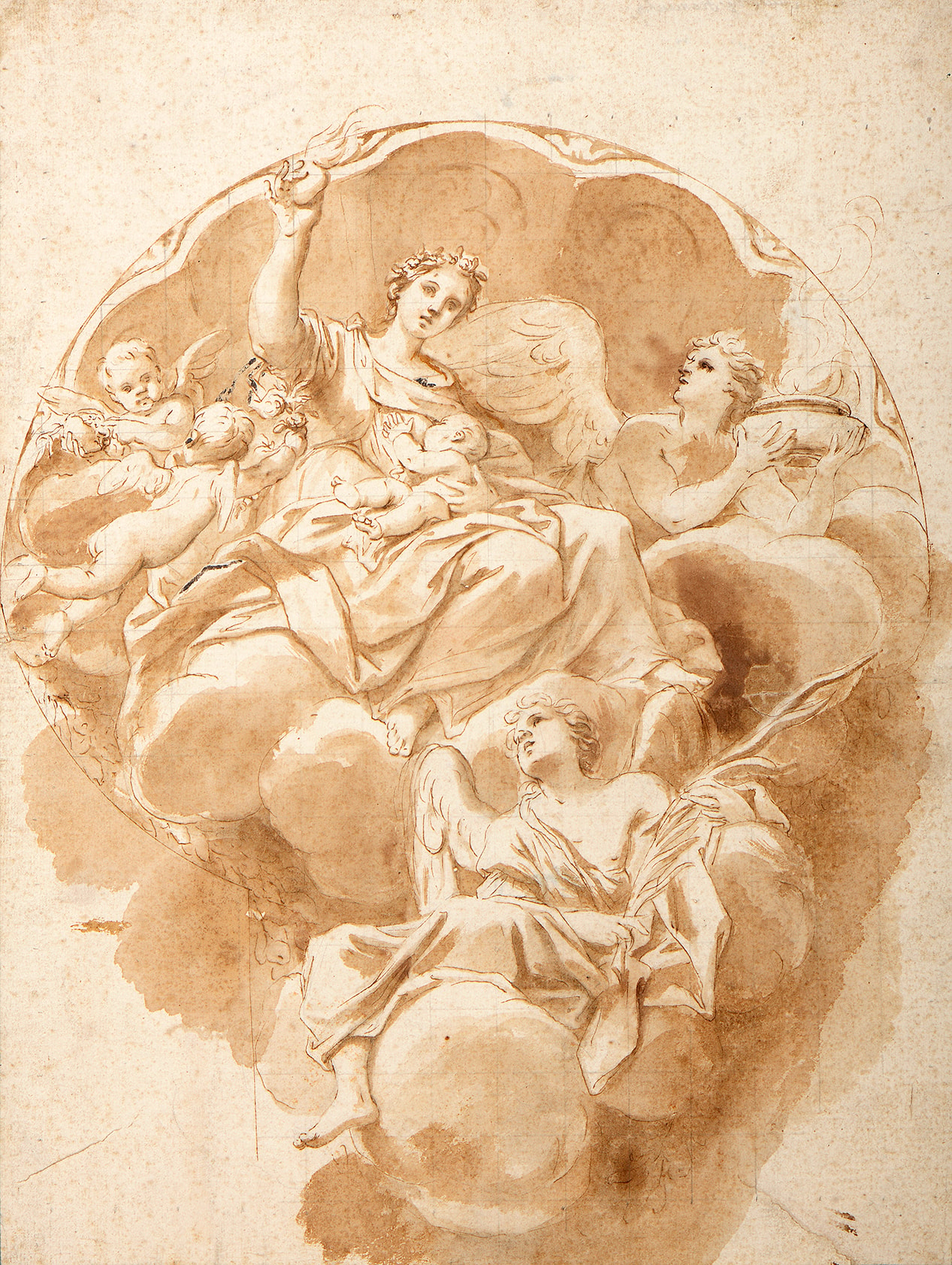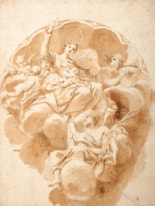Marcantonio FRANCESCHINI
(Bologna 1648 - Bologna 1729)
Charity
Sold
Pen and brown ink and brown wash, over traces of an underdrawing in black chalk.
Squared for transfer in black chalk.
388 x 291 mm. (15 1/4 x 11 1/2 in.)
Squared for transfer in black chalk.
388 x 291 mm. (15 1/4 x 11 1/2 in.)
This drawing is a study for the figure of Charity, one of four pendentives frescoed beneath the cupola of the cathedral at Piacenza by Marcantonio Franceschini between 1688 and 1689. The four pendentive frescoes - depicting allegorical female figures representing Charity, Faith, Chastity and Humility - were detached from the cupola during the renovation of the interior of the cathedral between 1894 and 1902, and were thereafter displayed in the Convento degli Agostiniani in Piacenza. Largely destroyed during the Allied aerial bombardment of the city in 1943, the frescoes survive today only as fragments, although their compositions are recorded in old photographs. Franceschini’s now-lost fresco of Charity, in its final form, differed only slightly from the composition of the present sheet, mainly in the completely different pose of the winged angel at the bottom.
Two other preparatory studies by Franceschini for the Piacenza Charity are known, one in the collection of the Museo Davia Bargellini in Bologna and the other in the Metropolitan Museum of Art in New York. Another related compositional drawing for the fresco of Charity at Piacenza, by a pupil or assistant of Franceschini, is in the Royal Collection at Windsor Castle. A close copy of the present sheet, probably by Franceschini’s chief pupil and assistant Giacomo Boni, is in the Uffizi in Florence.
The present sheet once belonged to the art dealer and collector Paul Wallraf (1897-1981).
Two other preparatory studies by Franceschini for the Piacenza Charity are known, one in the collection of the Museo Davia Bargellini in Bologna and the other in the Metropolitan Museum of Art in New York. Another related compositional drawing for the fresco of Charity at Piacenza, by a pupil or assistant of Franceschini, is in the Royal Collection at Windsor Castle. A close copy of the present sheet, probably by Franceschini’s chief pupil and assistant Giacomo Boni, is in the Uffizi in Florence.
The present sheet once belonged to the art dealer and collector Paul Wallraf (1897-1981).
A pupil of Carlo Cignani, Marcantonio Franceschini spent much of the 1670’s working as Cignani’s chief assistant. By the end of the decade he had begin to establish himself as an independent artist, producing altarpieces for churches in Bologna and the surrounding area. In 1680 he received first major fresco commission, for a ceiling decoration of Fortuna and the Four Seasons in the Palazzo Ranuzzi in Bologna. The success of this led to many further fresco commissions, notably in the cathedral at Piacenza (1688-1689), the church of San Bartolomeo Porta Ravegnata in Bologna (1690-1691), the Bolognese church of the Corpus Domini (1690-1696) and the Palazzo Ducale in Modena (1696). His work as a frescante culminated in the grandiose cycle of scenes from the history of the Republic of Genoa in the Palazzo Ducale in Genoa, painted between 1702 and 1704 but destroyed by fire in 1777. He also produced a large number of altarpieces and smaller scale devotional and mythological works for illustrious patrons from Emilia and beyond.
Among Franceschini’s most significant patrons was Prince Johann Adam Andreas of Liechtenstein, for whom he worked for almost two decades, between 1691 and 1709, painting numerous canvases to decorate several rooms in the Liechtenstein Garden Place in Vienna. The artist also served as an agent for the Prince in the acquisition of paintings in Italy. A founder member of the Accademia Clementina in Bologna in 1709, of which he later served a term as president, Franceschini was summoned to Rome in 1711 by Pope Clement XI to provide cartoons for the mosaic decoration of a chapel in St. Peter’s, for which he later earned a knighthood.
Provenance
Paul Wallraf, Paris and London
Given by him to the present owner
Private collection, London.




